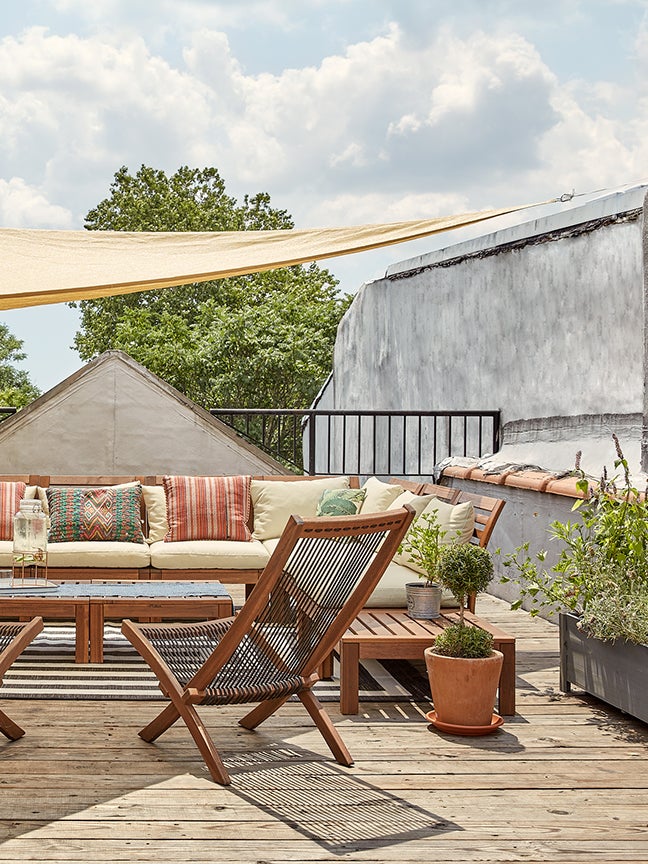6 Plants That Naturally Repel Mosquitoes
Gardening with a perk.
Updated Oct 11, 2018 5:04 PM
We may earn revenue from the products available on this page and participate in affiliate programs.
With all the joys that open-window, patio-dining summer weather brings, there’s one buzzing flaw in the plan: mosquitoes. Whether you have a sprawling backyard or just a balcony, you can’t escape them—or can you? If you’ve already tried sticky repellent sprays to no avail, perhaps some extra protection is in order. Luckily, you can grow your very own with the help of a couple pots.
“The most important plants to naturally repel mosquitoes are strong-scented ones,” explains Isabelle Palmer, author of Modern Container Gardening. Rebecca Bullene, cofounder of Greenery Unlimited, agrees: Her homegrown defense comes in the form of hanging baskets she has lining her porch and garden. The first step is making a couple environmental tweaks to create a less hospitable space for insects.
- Moisture: “Remove standing water,” instructs Palmer. “It encourages larvae to reproduce—these bugs can lay hundreds of eggs even in a tiny spoonful of it.”
- Air: If you’re trying to keep your apartment pest-free, Bullene recommends propping up a fan nearby. “You may have noticed they’re not around on windy days; that’s because their wings aren’t equipped to deal with gusts,” she explains.
Once you’ve adjusted accordingly, it’s time to start planting. We asked Palmer, Bullene, and Washington, D.C.–based gardening expert Dominique Charles to share their top picks for greens that double as natural mosquito repellents.
Lavender
It’s not just a sleep aid. This fragrant plant will kick unwanted visitors to the curb, thanks to the strong-smelling essential oils that are found in the leaves. Keep it in a dry, sunny spot to prolong its life span. “In the spring, cut back to the woody stems so you get a lovely mass of leaves forming mounds in the summer,” suggests Palmer.
Citronella
“This is my top pick because it’s incredibly easy to grow and propagate,” says Bullene. She plants hers in baskets with cascading flowers for a form-meets-function display. This option is as low-maintenance as they come; just be sure to bring it indoors in the winter. Palmer recommends buying the cymbopogon nardus or citronella winterianus varieties, as they produce the most potent smell.
Basil
Charles grows a lot of tomatoes; the byproduct of which is that she also plants a lot of basil (hello, caprese salads). Though there’s a hidden, nonculinary benefit to her method: “The sweet yet pungent scent of its leaves emits an aroma that, while delicious to people, is toxic to mosquitoes,” she explains. It contains estragole, a chemical compound that will keep insects at bay.
Marigolds
“A staple for any edible gardener, these keep more than just the aphids away—they’re also a reliable mosquito deterrent,” says Bullene of the easy-to-grow annual bloom. Pro tip: Stay on top of deadheading the buds and you’ll have sunny orange and yellow flowers from May through October. Charles arranges hers right next to her caprese garden for what she calls “the utmost triple threat” in natural bug protection.
Bee Balm
Otherwise known as monarda, this colorful flower attracts butterflies and pollinators but wards off mosquitoes. “It can be susceptible to powdery mildew, so be sure to plant it where it has space and air circulation around it,” warns Bullene. As long as you don’t overwater it, you can expect bright blossoms all the way through late summer.
Rosemary
There are so many ways to reap the benefits of this handy herb. Palmer swears by a DIY spray, made from boiling a kilogram of dried rosemary in a liter of water for 25 minutes, then straining the liquid into a container before topping up with cool water to make one liter total. “Store it in the refrigerator, then add it to small squirt bottles as needed when going outdoors,” she says. Charles, on the other hand, likes to hang a few sprigs of rosemary by the grill or firepit to create a fragrant smokiness that will keep your barbecue pest-free.
Introducing Domino’s new podcast, Design Time, where we explore spaces with meaning. Each week, join editor-in-chief Jessica Romm Perez along with talented creatives and designers from our community to explore how to create a home that tells your story. Listen now and subscribe for new episodes every Thursday.





